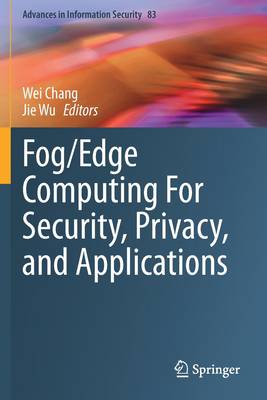
Bedankt voor het vertrouwen het afgelopen jaar! Om jou te bedanken bieden we GRATIS verzending (in België) aan op alles gedurende de hele maand januari.
- Afhalen na 1 uur in een winkel met voorraad
- Gratis thuislevering in België
- Ruim aanbod met 7 miljoen producten
Bedankt voor het vertrouwen het afgelopen jaar! Om jou te bedanken bieden we GRATIS verzending (in België) aan op alles gedurende de hele maand januari.
- Afhalen na 1 uur in een winkel met voorraad
- Gratis thuislevering in België
- Ruim aanbod met 7 miljoen producten
Zoeken
Fog/Edge Computing for Security, Privacy, and Applications
€ 158,45
+ 316 punten
Omschrijving
This book provides the state-of-the-art development on security and privacy for fog/edge computing, together with their system architectural support and applications. This book is organized into five parts with a total of 15 chapters. Each area corresponds to an important snapshot. The first part of this book presents an overview of fog/edge computing, focusing on its relationship with cloud technology and the future with the use of 5G communication. Several applications of edge computing are discussed. The second part of this book considers several security issues in fog/edge computing, including the secure storage and search services, collaborative intrusion detection method on IoT-fog computing, and the feasibility of deploying Byzantine agreement protocols in untrusted environments. The third part of this book studies the privacy issues in fog/edge computing. It first investigates the unique privacy challenges in fog/edge computing, and then discusses a privacy-preservingframework for the edge-based video analysis, a popular machine learning application on fog/edge. This book also covers the security architectural design of fog/edge computing, including a comprehensive overview of vulnerabilities in fog/edge computing within multiple architectural levels, the security and intelligent management, the implementation of network-function-virtualization-enabled multicasting in part four. It explains how to use the blockchain to realize security services. The last part of this book surveys applications of fog/edge computing, including the fog/edge computing in Industrial IoT, edge-based augmented reality, data streaming in fog/edge computing, and the blockchain-based application for edge-IoT. This book is designed for academics, researchers and government officials, working in the field of fog/edge computing and cloud computing. Practitioners, and business organizations (e.g., executives, system designers, and marketing professionals), who conduct teaching, research, decision making, and designing fog/edge technology will also benefit from this book The content of this book will be particularly useful for advanced-level students studying computer science, computer technology, and information systems, but also applies to students in business, education, and economics, who would benefit from the information, models, and case studies therein.
Specificaties
Betrokkenen
- Uitgeverij:
Inhoud
- Aantal bladzijden:
- 418
- Taal:
- Engels
- Reeks:
- Reeksnummer:
- nr. 83
Eigenschappen
- Productcode (EAN):
- 9783030573300
- Verschijningsdatum:
- 6/01/2022
- Uitvoering:
- Paperback
- Formaat:
- Trade paperback (VS)
- Afmetingen:
- 156 mm x 234 mm
- Gewicht:
- 598 g

Alleen bij Standaard Boekhandel
+ 316 punten op je klantenkaart van Standaard Boekhandel
Beoordelingen
We publiceren alleen reviews die voldoen aan de voorwaarden voor reviews. Bekijk onze voorwaarden voor reviews.











